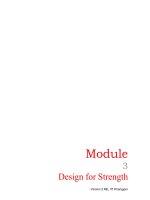Tài liệu Fundamentals of Machine Design P7 docx
Bạn đang xem bản rút gọn của tài liệu. Xem và tải ngay bản đầy đủ của tài liệu tại đây (541.22 KB, 21 trang )
Version 2 ME, IIT Kharagpur
Module
3
Design for Strength
Version 2 ME, IIT Kharagpur
Lesson
1
Design for static loading
Version 2 ME, IIT Kharagpur
Instructional Objectives
At the end of this lesson, the students should be able to understand
• Types of loading on machine elements and allowable stresses.
• Concept of yielding and fracture.
• Different theories of failure.
• Construction of yield surfaces for failure theories.
• Optimize a design comparing different failure theories
3.1.1 Introduction
Machine parts fail when the stresses induced by external forces exceed their
strength. The external loads cause internal stresses in the elements and the
component size depends on the stresses developed. Stresses developed in a
link subjected to uniaxial loading is shown in figure-3.1.1.1. Loading may be due
to:
a) The energy transmitted by a machine element.
b) Dead weight.
c) Inertial forces.
d) Thermal loading.
e) Frictional forces.
Version 2 ME, IIT Kharagpur
Time
Load
Load
Time
Load
Time
Load
Time
3.1.1.1A- Stresses developed in a link subjected to uniaxial loading
In another way, load may be classified as:
a) Static load- Load does not change in magnitude and direction and
normally increases gradually to a steady value.
b) Dynamic load- Load may change in magnitude for example, traffic of
varying weight passing a bridge.Load may change in direction, for
example, load on piston rod of a double acting cylinder.
Vibration and shock are types of dynamic loading. Figure-3.1.1.2 shows load vs
time characteristics for both static and dynamic loading of machine elements.
Static Loading
Dynamic Loading
3.1.1.2F - Types of loading on machine elements.
Version 2 ME, IIT Kharagpur
SPACE FOR A UNIVERSAL TENSILE TEST CLIPPING
3.1.2 Allowable Stresses: Factor of Safety
Determination of stresses in structural or machine components would be
meaningless unless they are compared with the material strength. If the induced
stress is less than or equal to the limiting material strength then the designed
component may be considered to be safe and an indication about the size of the
component is obtained. The strength of various materials for engineering
applications is determined in the laboratory with standard specimens. For
example, for tension and compression tests a round rod of specified dimension is
used in a tensile test machine where load is applied until fracture occurs. This
test is usually carried out in a Universal testing machine of the type shown in
clipping- 3.1.2.1. The load at which the specimen finally ruptures is known as
Ultimate load and the ratio of load to original cross-sectional area is the Ultimate
stress.
3.1.2.1V
Similar tests are carried out for bending, shear and torsion and the results for
different materials are available in handbooks. For design purpose an allowable
stress is used in place of the critical stress to take into account the uncertainties
including the following:
1) Uncertainty in loading.
2) Inhomogeneity of materials.
3) Various material behaviors. e.g. corrosion, plastic flow, creep.
4) Residual stresses due to different manufacturing process.
Version 2 ME, IIT Kharagpur
UltimateStress
F.S.
AllowableStress
=
5) Fluctuating load (fatigue loading): Experimental results and plot- ultimate
strength depends on number of cycles.
6) Safety and reliability.
For ductile materials, the yield strength and for brittle materials the ultimate
strength are taken as the critical stress.
An allowable stress is set considerably lower than the ultimate strength. The ratio
of ultimate to allowable load or stress is known as factor of safety i.e.
The ratio must always be greater than unity. It is easier to refer to the ratio of
stresses since this applies to material properties.
3.1.3 Theories of failure
When a machine element is subjected to a system of complex stress system, it is
important to predict the mode of failure so that the design methodology may be
based on a particular failure criterion. Theories of failure are essentially a set of
failure criteria developed for the ease of design.
In machine design an element is said to have failed if it ceases to perform its
function. There are basically two types of mechanical failure:
(a)
Yielding
- This is due to excessive inelastic deformation rendering the
machine
part unsuitable to perform its function. This mostly occurs in ductile
materials.
(b)
Fracture
- in this case the component tears apart in two or more parts. This
mostly occurs in brittle materials.
There is no sharp line of demarcation between ductile and brittle materials.
However a rough guideline is that if percentage elongation is less than 5%
then the material may be treated as brittle and if it is more than 15% then the
Version 2 ME, IIT Kharagpur
material is ductile. However, there are many instances when a ductile
material may fail by fracture. This may occur if a material is subjected to
(a) Cyclic loading.
(b) Long term static loading at elevated temperature.
(c) Impact loading.
(d) Work hardening.
(e) Severe quenching.
Yielding and fracture can be visualized in a typical tensile test as shown in the
clipping- Typical engineering stress-strain relationship from simple tension
tests for same engineering materials are shown in
figure- 3.1.3.1
.
3.1.3.1F- (a) Stress-strain diagram for a ductile material e.g. low carbon
steel.
Stress
Strain
Plastic rangeElastic range
(True)
f (Engineering)
U
P
Y
σ
y
Version 2 ME, IIT Kharagpur
3.1.3.1F- (b) Stress-strain diagram for low ductility.
3.1.3.1F- (c) Stress-strain diagram for a brittle material.
3.1.3.1F- (d) Stress-strain diagram for an elastic – perfectly plastic
material.
Stress
Strain
Y
U
(True)
f (Engineering)
0.2 % offset
Strain
Stress
f (Ultimate fracture)
σ
y
Stress
Strain









